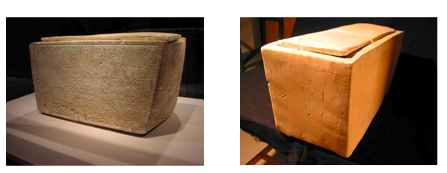Today's New York Times carries a story, "Findings Reignite Debate on Claims of Jesus' Bones," reporting that new chemical tests done on the ossuaries from the Talpiot "Jesus" tomb comparing it with the controversial "James son of Joseph, brother of Jesus" ossuary show a close "match" between the two.
Dr. Aryeh Shimon is interviewed on the results of these tests that compare extensive scrapings from inside and outside ossuaries carried out by the Israel Antiquities Authority of comparative ancient tombs of the same period in Jerusalem. Previously, tests had been done on patina, as noted below, but the new tests were of a far more telling nature, accessing the limestone beneath the patina. Limestone ossuaries over time absorb the soil and chemical environs of the tomb they are placed in. Each tomb has a characteristic chemical profile unique to its environment. The two ossuaries also have a surprisingly similar style and appearance:
Dr. Shimron's conclusion is that there is an extremely high probability that the James ossuary was originally taken from the Talpiot tomb, either around 1980 when it was discovered, or perhaps earlier, since the tomb itself was unsealed.
I might also point out that an ossuary from the nearby Talpiot tomb B was also sampled, just 60 meters away, and it did not match at all the Talpiot "Jesus" tomb ossuaries (Tomb A), as well as ossuaries from over a dozen randomly chosen Jerusalem 1st century tombs. These served as comparative control. These results show that the "Jesus tomb" had a very specific and unique chemical environment-even with a tomb quite close by.
Statisticians agree that adding the James ossuary to the names that are already in the Talpiot tomb (Jesus son of Joseph, Mariah, Mariamene, Yose, Mattai, Jude) changes everything in favor of its high probability of being the tomb of Jesus of Nazareth and his family, see the calculations by Kilty and Elliot, "The James Ossuary and the Talpiot Tomb."
Although millions of Christians believe that the "resurrection of Jesus" implies that his physical body was revived and subsequently taken up to heaven, our earliest literary witness to Jesus' resurrection is the apostle Paul -- our Gospels were written decades after Paul's letters. Paul writes of leaving behind the mortal body like discarded clothing and being "re-clothed" in a new "spiritual body" (2 Corinthians 5:1-4; 1 Corinthians 15:35-45). He refers to the "risen Christ" as a "life-giving Spirit."
It is not at all clear that his faith would be threatened by the discovery of Jesus' family tombs, even with his earthly "remains" left behind. I am convinced that the earliest Christian view of resurrection is not threatened by any of these latest discoveries and the notion of Jesus and his beloved brother James, united in life as in death, is an exceptionally moving one.

